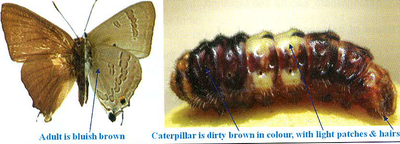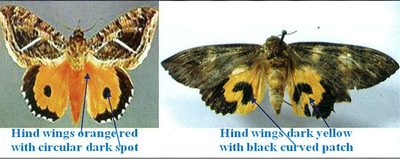Insect pest of Pomegranate in Hot Arid Region
Insect pest of Pomegranate in Hot Arid Region
Pomegranate Butterfly (Deudorix isocrates)
- It is widely distributed all over India and is found wherever pomegranates are grown.
Host Range
- It is a polyphagous pest having a very wide range of host plants, including, aonla, apple, ber, citrus, guava, litchi, loquat, mulberry, peach, pear, plum, pomegranate, sapota and tamarind.
Nature of Damage
- On hatching, the caterpillars bore inside the developing fruits and are usually found feeding on pulp and seeds just below the rind.
- As many as eight caterpillars may be found in a single fruit.
- The conspicuous symptoms of damage are offensive smell and excreta of the caterpillars coming out of entry holes, the excreta are found stuck around the holes.

- Sometimes the holes may also be seen plugged with the anal end of a caterpillar.
- The affected fruits ultimately fall down and are of no use.
Description
- Eggs are laid singly on calyx of flowers or tender fruits.
- Caterpillar is stoutly built dirty brown in colour, with light patches, a few short hairs and measures about 16-20 mm long.

- Larval period is 18-47 days.
- The adult is bluish brown.
- On female adult V shaped patch on forewing.
Management
- Remove and destroy the affected fruits.
- Before maturity, bag the fruits with butter paper.
- Clip off calyx cup immediately after pollination followed by two applications of neem oil @ 3 %.
- Release T. chilonis at 2.5 lakh/ha, four times at ten days interval has been recommended.
- At flowering stage, spray NSKE 5% or neem formulations 2 ml/1.
- Spray deltamethrin 2.8 EC (1.5 ml/litre of water) at fortnightly interval from the stage of flowering to fruit development.
- Spray malathion 50 EC 0.1% or azadirachtin 1500ppm @ 3.0 ml/l at 15 days intervals commencing from initiation of flowering up to the harvesting subjected to the presence of fruit borer
Fruit sucking moths (Eudocima fullonica & E. maternal)
- This pest is distributed in Australia, China, Japan, Korea, Philippines, Hawai, Thailand, India etc. The caterpillars of these are leaf defoliators on weed hosts viz., Tinospora cardifolia, Cocculus pendulus and C. hirsutus.
Host Range
- Besides citrus, it also attacks pomegranate, grapes, apple, castor, ber, guava etc.
Nature of Damage
- It is only the moths that are destructive to citrus fruits.
- The moths are distinguished by having particularly well developed proboscis with dentate tips with which they are able to pierce the ripening fruits.
- The moths are nocturnal in habit and may be seen flying about in orchards after dusk especially during rainy season.
- The damaged fruits soon start rotting as the punctured regions are easily infected with bacteria and fungi and ultimately the fruits drop prematurely.
Description
- The adults of O. fullonica has pale orange brown body with forewings dark greyish and the hind wings orange red with two black curved patches.
- The adults of O. materna has pale greenish gray upper wings with pale white markings and the lower wings with a marginal dark brown region mixed with white spots and a circular dark spot.

- The caterpillar is a semilooper, dark brown with yellow and red spots.
- Full grown caterpillars are 50 - 60 mm long, stout, velvety-blue with yellow patterns on dorsal and lateral sides and having a hump at anal end.
Management
- Systematic destruction of weed host plants on which the caterpillars feed in the vicinity of orchards helps to check the pest population.
- Bagging of fruits has been suggested in small scale.
- Creating smoke in the orchards after sunset may keep the pest at bay.
- Covering the entire orchard with nylon net followed by spray with contact insecticide has been recommended.
- Spraying oil emulsions once in 10 days to act as a deterrent.
- Poison baiting (20 g malathion 50% W.P. + 200 g jaggery or molasses in 2 L of water) has been found quite affective.
Source: Insect Pest Of Arid Fruit Crops
IPM for Pomegranate
To know the IPM practices for Pomegranate, click here.
Last Modified : 3/29/2021
© C–DAC.All content appearing on the vikaspedia portal is through collaborative effort of vikaspedia and its partners.We encourage you to use and share the content in a respectful and fair manner. Please leave all source links intact and adhere to applicable copyright and intellectual property guidelines and laws.
RELATED ITEMS
Agriculture Skill Council of India (ASCI)
Provides information about Agriculture Skill Counc...
PM Kisan Maandhan Yojana
This topic provides information about PM Kisan Maa...
Best practices in implementation of PMFBY
This topic provides information about Best practic...
District Agriculture Plan
Provides summary of District Agriculture Plan Wash...
RELATED LANGUAGES
